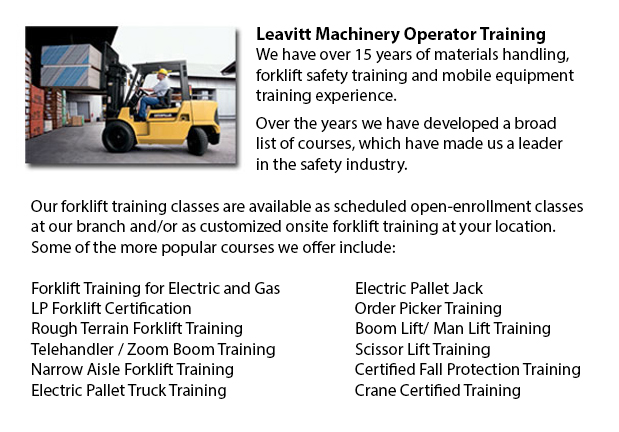
Sudbury Forklift Training School - Forklift Training School - For The Safety Of Both The Machine And The User - Industry and federal regulators have established the criteria for forklift safety training according to their current regulations and standards. Those wanting to operate a forklift should finish a forklift training School prior to making use of one of these equipment. The accredited Forklift Operator Training Program is intended to offer trainees with the practical skills and knowledge to become a forklift operator.
Mobile Equipment and Vehicle safety regulations which apply to forklift operation include pre-shift checks, and rules for lifting and loading.
An inspection checklist should be done and submitted to the supervising authority before beginning a shift. When a maintenance issue is uncovered, the use of the specific machine must be stopped until the issue has been dealt with. To be able to indicate the equipment is out of service, the keys have to be removed from the ignition and a warning tag placed in a location that is seen.
Loading safety rules include checking the forklift nameplate's rating capacity and determining if the weight of the load falls within capacity. The forklift forks must be in the down position when the forklift is starting up. Remember that there is a loss of around 100 pounds carrying capacity for every inch further away from the carriage which the load is carried.
Lifting should begin with the driver moving to a stopped position approximately three inches from the load. The mast should then be leveled until it has reached a right angle with the load. Lift the forks to an inch beneath the slot on the pallet and drive forward. Afterward lift forks four inches. Tilt back the load to be able to secure it for moving. Drive the lift backwards if the load obscures frontal vision. Check behind and honk in order to alert other employees. Do not allow forks to drag on the ground.
-
Wheel and Track Loader Training in Sudbury
Lift trucks are obtainable in several different models that have different load capacities. The majority of average forklifts used in warehouse environment have load capacities of 1-5 tons. Bigger scale units are utilized for heavier loads, like for... More -
Sudbury Aerial Lift Certification
Sudbury Aerial Lift Certification - Aerial Lift Certification is for individuals who requires an in-depth understanding of aerial lift safety. Inspectors and operators, supervisors, maintenance workers and construction craftsmen must perform a traini... More -
Sudbury Forklift Certification Schools
Sudbury Forklift Certification Schools - Within North America, forklift certification is mandatory, making forklift training programs necessary for both the company and their employees working as forklift operators. Forklift training focuses on healt... More -
Sudbury Boom Lift Operator Training
Sudbury Boom Lift Operator Training - A cherry picker refers to a type of aerial work platform. Cherry pickers include a platform or bucket at the end of a hydraulic lifting system. The device is likewise called a man lift, boom lift, basket crane or... More -
Sudbury Telehandler Certification
Sudbury Telehandler Certification - Telehandler certification programs are both for operators who have some experience driving a standard forklift and for those with no experience. The real-world training offered by these courses produces graduates w... More -
Operator Safety Training, Re-Qualification Training, In-House Instructor Training in Sudbury
Lift trucks are utilized in just about all industrial construction sites and in warehouse operations and in boat yards. The reach feature of a lift truck is a vital component used in several applications like for example when a shelving system is bei... More -
Crane / Overhead Crane / Self-Erect Crane / Truck Mounted Crane / Hydraulic Cranes Training in Sudbury
Bridge cranes or overhead cranes are a type of industrial material handling crane making use of a line and hook apparatus which runs on a horizontal beam running along two widely separated rails. Lots of overhead cranes could be seen in a long factor... More -
Sudbury Forklift Safety Training
Sudbury Forklift Safety Training - Anyone who wants to operate a lift truck should take a forklift safety training course in order to become a certified forklift truck operator. There are a variety of ways to obtain forklift training. Programs are pr... More

Forklift Certification Sudbury
TOLL FREE: 1-888-254-6157
Sudbury, Ontario
forkliftcertificationsudbury.com
Email Us
About Us


